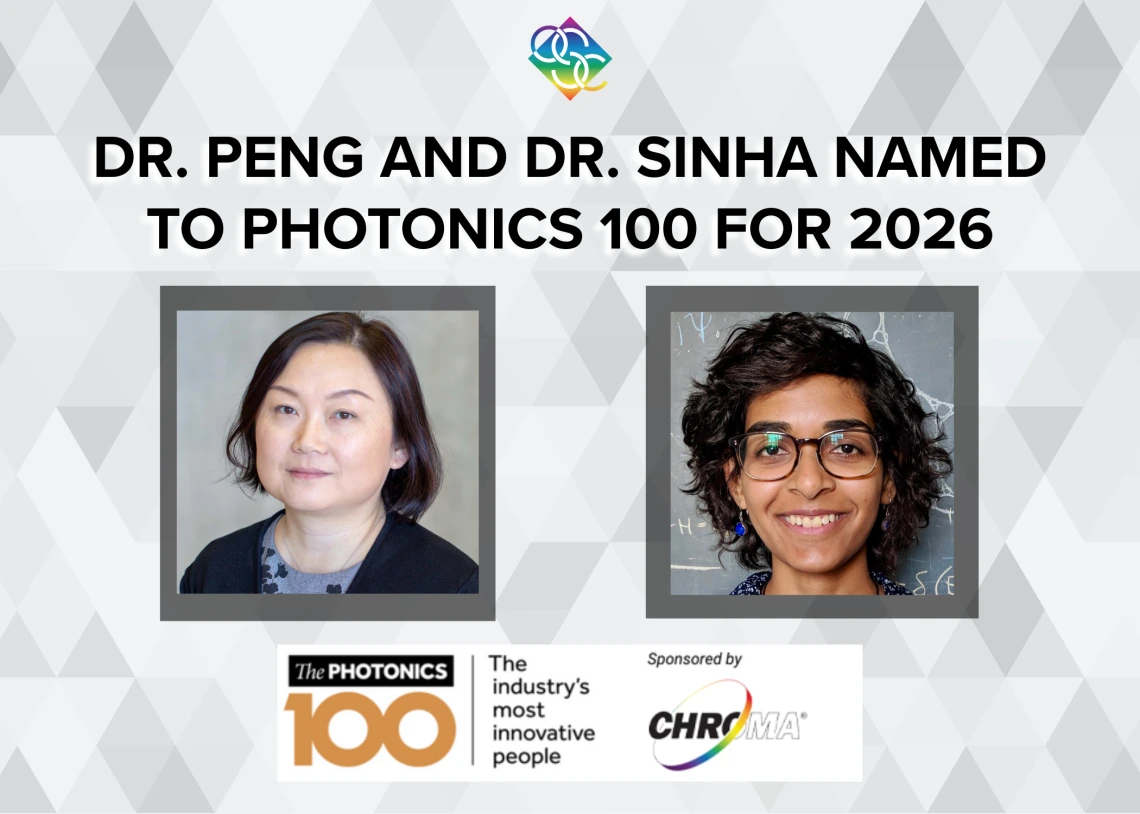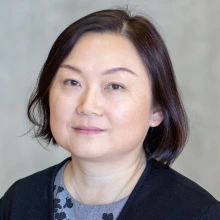Dr. Leilei Peng and Dr. Kanu Sinha Join the Photonics100 2026

We’re proud to share that two of our faculty members, Dr. Leilei Peng and Dr. Kanu Sinha, have been named to the Photonics 100 for 2026, an international list recognizing the most innovative and influential people in photonics.

Dr. Leilei Peng, Associate Professor of Optical Sciences, is a pioneer in biophotonics. Her work focuses on developing advanced 3D fluorescence microscopy systems that push the limits of imaging depth, resolution, and speed. Her patented technologies include systems capable of capturing large-volume tissue images at subcellular resolution and imaging transient biological activity at 100 volumes per second. She is also the inventor of FmFLIM for dual FRET sensor imaging in live embryos and spectral-SIM light sheet imaging for fast, synchronous 3D imaging with multiple fluorescent proteins. Dr. Peng’s research spans from concept to application, with collaborations in neuroscience and cancer biology that demonstrate the real-world impact of her imaging innovations.

Dr. Kanu Sinha, Assistant Professor of Optical Sciences, specializes in quantum optics, exploring light-matter interactions at the quantum level. Her group’s research focuses on engineering efficient light-matter interfaces using collective many-body dynamics, nanoscale interactions, and non-Markovian photonic environments, where a system’s future evolution depends on its past. Her theoretical work on waveguide quantum electrodynamics has directly inspired experimental setups that probe delay-induced quantum effects.
Congratulations to Dr. Peng and Dr. Sinha for this well-deserved recognition!
The Photonics100 2026: Celebrating the Industry’s Most Innovative Minds in a Year of Disruption and Opportunity
Electro Optics is proud to announce the 2026 edition of The Photonics100, recognising the 100 most innovative people shaping the future of photonics worldwide. Against a backdrop of geopolitical upheaval, technological transformation, and surging global demand, this year’s honourees represent the brightest talent navigating disruption with ingenuity and vision.
The photonics industry stands at a pivotal inflection point. Artificial intelligence (AI) is reshaping computing and fuelling insatiable demand for optical interconnects. Quantum communications and integrated photonics are advancing from research to real-world deployment. Meanwhile, supply chain shocks and shifting global alliances have forced companies to rethink everything from sourcing strategies to manufacturing hubs.
Yet within these challenges lies extraordinary opportunity. The Photonics100 2026 cohort demonstrates how innovation—whether in advanced lasers, integrated circuits, biomedical sensing, or quantum systems—remains the industry’s most powerful answer to uncertainty.
Global Shifts, Local Strengths
For the first time, the United Kingdom takes the top spot in the global tally, with 21 honourees, reflecting its booming £18.5bn photonics sector. Germany follows with 19, and the United States drops to third with 17, down sharply from its previous dominance. Europe overall continues to lead, with 73 of this year’s innovators based across the continent.
Elsewhere, new entrants signal fresh momentum: China, Uruguay, and South Korea each make their debut in the ranking. North America contributes 20 honourees, while activity in Asia-Pacific shows encouraging signs of growth.
What’s Driving Innovation in 2026
This year’s Photonics100 are advancing research and technology in five broad areas:
- Next-generation optical communication and networking: from high-capacity engines for AI clusters to quantum-enhanced position, navigation and timing.
- Advanced laser systems and materials processing: including ultra-short pulse lasers, additive manufacturing, and long-lifetime UV sources.
- Integrated photonics and chip-scale devices: scaling photonic integrated circuits across multiple platforms for quantum, sensing, and lidar.
- Novel sensing and imaging: enabling breakthroughs in agriculture, medical diagnostics, and bioprocessing.
- Quantum technologies: pushing forward scalable architectures, secure communication networks, and quantum-enhanced infrastructure.
Key Challenges and Opportunities
When asked about the road ahead, honourees pointed to five defining issues:
- Scaling and manufacturing: bridging the gap between lab innovation and industrial production remains the top challenge.
- Geopolitical and economic uncertainty: tariffs, supply chain fragility, and shifting funding priorities are testing resilience.
- Talent shortages: competition for skilled engineers and scientists continues to constrain growth.
- AI integration: both a challenge and a transformative opportunity for productivity and automation.
- Application-specific opportunities: spanning biomedical diagnostics, aerospace, defence, data centre efficiency, and beyond.
Despite uncertainty, confidence in photonics investment remains high. Over 60% of this year’s honourees expect their R&D budgets to increase in the next 12 months, with nearly half anticipating significant growth of more than 20%.
Voices from the Industry
“Photonics is outperforming much of the wider economy,” said John Lincoln, CEO of the Photonics Leadership Group and an early Photonics100 honouree. “AI, life sciences, defence, and laser processing are driving demand across every application area, with the UK playing a central role.”
In Germany, however, geopolitical risk has emerged as the number one concern. Sven Breitung, Managing Director of the VDMA Working Group Lasers, pointed to trade tensions and tariffs as “the first time a single person has become a challenge for the industry”—a direct reference to US President Donald Trump’s economic policies.
The Future of Photonics
The 2026 Photonics100 shines a spotlight on a sector that is both under pressure and bursting with potential. From wafer-scale photonic computing to non-invasive biomedical diagnostics, the honourees embody the resilience and creativity needed to propel the industry forward.
“Every challenge photonics faces—whether technical, economic, or political—is matched by an opportunity to innovate,” said Warren Clark, Managing Director of Europa Science, publisher of Electro Optics. “The Photonics100 celebrates those leading the way.”
About The Photonics100
Launched in 2023, The Photonics100 recognises 100 innovators each year who are shaping the global photonics landscape. Honourees are selected for their pioneering work in academia, industry, and entrepreneurship, spanning applications from quantum to biomedical, and lasers to optical communications.
Andrew Knight
Audience Engagement Manager, Electro Optics
andrew.knight@europascience.com
